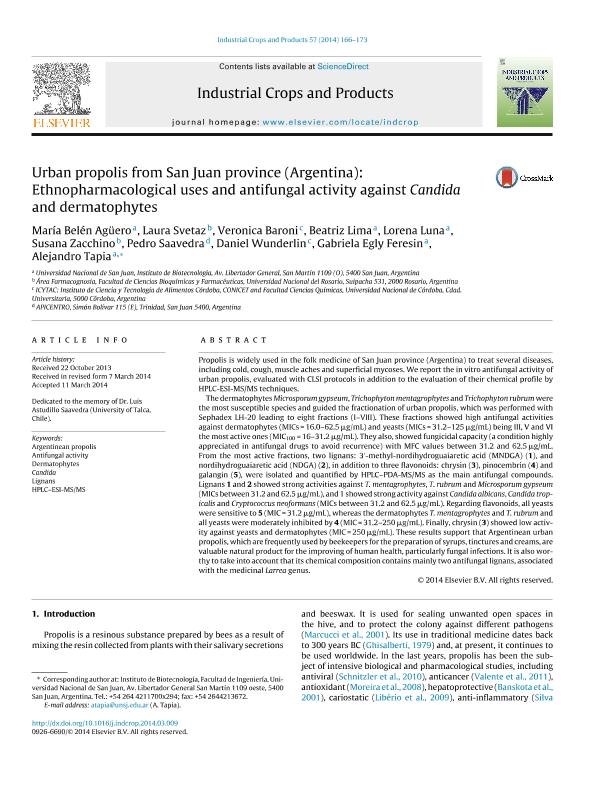Mostrar el registro sencillo del ítem
dc.contributor.author
Aguero, María Belen
dc.contributor.author
Svetaz, Laura Andrea

dc.contributor.author
Baroni, María Verónica

dc.contributor.author
Lima, Beatriz Viviana

dc.contributor.author
Luna, Lorena Celina

dc.contributor.author
Zacchino, Susana Alicia Stella

dc.contributor.author
Saavedra, Pedro
dc.contributor.author
Wunderlin, Daniel Alberto

dc.contributor.author
Feresin, Gabriela Egly

dc.contributor.author
Tapia, Aníbal Alejandro

dc.date.available
2017-12-05T15:43:22Z
dc.date.issued
2014-03
dc.identifier.citation
Aguero, María Belen; Svetaz, Laura Andrea; Baroni, María Verónica; Lima, Beatriz Viviana; Luna, Lorena Celina; et al.; Urban propolis from San Juan province (Argentina): Ethnopharmacological uses and antifungal activity against Candida and dermatophytes; Elsevier Science; Industrial Crops and Products; 57; 3-2014; 166-173
dc.identifier.issn
0926-6690
dc.identifier.uri
http://hdl.handle.net/11336/29712
dc.description.abstract
Propolis is widely used in the folk medicine of San Juan province (Argentina) to treat several diseases, including cold, cough, muscle aches and superficial mycoses. We report the in vitro antifungal activity of urban propolis, evaluated with CLSI protocols in addition to the evaluation of their chemical profile by HPLC-ESI-MS/MS techniques. The dermatophytes Microsporum gypseum, Trichophyton mentagrophytes and Trichophyton rubrum were the most susceptible species and guided the fractionation of urban propolis, which was performed with Sephadex LH-20 leading to eight fractions (I–VIII). These fractions showed high antifungal activities against dermatophytes (MICs = 16.0–62.5 μg/mL) and yeasts (MICs = 31.2–125 μg/mL) being III, V and VI the most active ones (MIC100 = 16–31.2 μg/mL). They also, showed fungicidal capacity (a condition highly appreciated in antifungal drugs to avoid recurrence) with MFC values between 31.2 and 62.5 μg/mL. From the most active fractions, two lignans: 3′-methyl-nordihydroguaiaretic acid (MNDGA) (1), and nordihydroguaiaretic acid (NDGA) (2), in addition to three flavonoids: chrysin (3), pinocembrin (4) and galangin (5), were isolated and quantified by HPLC–PDA-MS/MS as the main antifungal compounds. Lignans 1 and 2 showed strong activities against T. mentagrophytes, T. rubrum and Microsporum gypseum (MICs between 31.2 and 62.5 μg/mL), and 1 showed strong activity against Candida albicans, Candida tropicalis and Cryptococcus neoformans (MICs between 31.2 and 62.5 μg/mL). Regarding flavonoids, all yeasts were sensitive to 5 (MIC = 31.2 μg/mL), whereas the dermatophytes T. mentagrophytes and T. rubrum and all yeasts were moderately inhibited by 4 (MIC = 31.2–250 μg/mL). Finally, chrysin (3) showed low activity against yeasts and dermatophytes (MIC = 250 μg/mL). These results support that Argentinean urban propolis, which are frequently used by beekeepers for the preparation of syrups, tinctures and creams, are valuable natural product for the improving of human health, particularly fungal infections. It is also worthy to take into account that its chemical composition contains mainly two antifungal lignans, associated with the medicinal Larrea genus
dc.format
application/pdf
dc.language.iso
eng
dc.publisher
Elsevier Science

dc.rights
info:eu-repo/semantics/openAccess
dc.rights.uri
https://creativecommons.org/licenses/by-nc-sa/2.5/ar/
dc.subject
Argentinean Propolis
dc.subject
Antifungal Activity
dc.subject
Dermatophytes
dc.subject
Candida
dc.subject
Lignans
dc.subject
Hplc–Esi-Ms/Ms
dc.subject.classification
Otras Ciencias Químicas

dc.subject.classification
Ciencias Químicas

dc.subject.classification
CIENCIAS NATURALES Y EXACTAS

dc.title
Urban propolis from San Juan province (Argentina): Ethnopharmacological uses and antifungal activity against Candida and dermatophytes
dc.type
info:eu-repo/semantics/article
dc.type
info:ar-repo/semantics/artículo
dc.type
info:eu-repo/semantics/publishedVersion
dc.date.updated
2017-12-05T15:21:34Z
dc.journal.volume
57
dc.journal.pagination
166-173
dc.journal.pais
Países Bajos

dc.journal.ciudad
Amsterdam
dc.description.fil
Fil: Aguero, María Belen. Universidad Nacional de San Juan; Argentina
dc.description.fil
Fil: Svetaz, Laura Andrea. Universidad Nacional de Rosario. Facultad de Ciencias Bioquímicas y Farmacéuticas; Argentina
dc.description.fil
Fil: Baroni, María Verónica. Consejo Nacional de Investigaciones Científicas y Técnicas. Centro Científico Tecnológico Conicet - Córdoba. Instituto de Ciencia y Tecnología de Alimentos Córdoba. Universidad Nacional de Córdoba. Facultad de Ciencias Químicas. Instituto de Ciencia y Tecnología de Alimentos Córdoba; Argentina
dc.description.fil
Fil: Lima, Beatriz Viviana. Universidad Nacional de San Juan; Argentina. Consejo Nacional de Investigaciones Científicas y Técnicas; Argentina
dc.description.fil
Fil: Luna, Lorena Celina. Universidad Nacional de San Juan; Argentina
dc.description.fil
Fil: Zacchino, Susana Alicia Stella. Universidad Nacional de Rosario. Facultad de Ciencias Bioquímicas y Farmacéuticas; Argentina. Consejo Nacional de Investigaciones Científicas y Técnicas; Argentina
dc.description.fil
Fil: Saavedra, Pedro. APICENTRO; Argentina
dc.description.fil
Fil: Wunderlin, Daniel Alberto. Consejo Nacional de Investigaciones Científicas y Técnicas. Centro Científico Tecnológico Conicet - Córdoba. Instituto de Ciencia y Tecnología de Alimentos Córdoba. Universidad Nacional de Córdoba. Facultad de Ciencias Químicas. Instituto de Ciencia y Tecnología de Alimentos Córdoba; Argentina
dc.description.fil
Fil: Feresin, Gabriela Egly. Universidad Nacional de San Juan; Argentina. Consejo Nacional de Investigaciones Científicas y Técnicas; Argentina
dc.description.fil
Fil: Tapia, Aníbal Alejandro. Universidad Nacional de San Juan; Argentina. Consejo Nacional de Investigaciones Científicas y Técnicas; Argentina
dc.journal.title
Industrial Crops and Products

dc.relation.alternativeid
info:eu-repo/semantics/altIdentifier/url/http://www.sciencedirect.com/science/article/pii/S0926669014001435
dc.relation.alternativeid
info:eu-repo/semantics/altIdentifier/doi/http://dx.doi.org/10.1016/j.indcrop.2014.03.009
Archivos asociados
